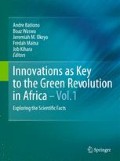Abstract
Phosphorus (P) application is essential for crop production in the weathered, P-fixing soils of Western Kenya. It is hypothesized that a single large application of phosphorus fertilizer can shift soil-available P levels above a critical threshold, while further seasonal applications are requisite for sustaining yields. A field study was conducted in Siaya district to evaluate maize yield, P uptake, soil P balance and economic returns from P applied at different initial P rates and further seasonal P additions. In the first season, triple superphosphate (TSP) was added at rates of 0, 15, 30, 50, 100, 150 and 250 kg P ha–1, and maize yield and P uptake were assessed during 10 consecutive seasons. Additional treatments were included where an initial application of 100 kg P ha–1 was supplemented with seasonal additions of 7 kg P ha–1, supplied as TSP, manure or Tithonia diversifolia. Residual benefits of maize in terms of increased grain yields were high with cumulative yields ranging from 17.4 to 54.8 t ha–1 when P was applied at rates above 100 kg P ha–1. Resin-extractable P increased significantly with initial P addition but decreased rapidly with time, particularly for treatments with one-time high dose of P application. Economic evaluation of these technologies revealed that application of initial P as 100 kg P ha–1 with seasonal additions of 7 kg P ha–1 as TSP would give the best marginal returns to investment.
Access this chapter
Tax calculation will be finalised at checkout
Purchases are for personal use only
References
Anderson JM, Ingram JSI (1993) Tropical soil biology and fertility. A hard book on methods. CAB International, Wallingford, UK, 221pp
Blake L, Mercik S, Koerschens M, Moskal S, Poulton PR, Goulding KWT, Weigel A, Powlson DS (2006) Phosphorus content in soil, uptake by plants and balance in three European long-term field experiments. Nutr Cycling Agroecosyst 56:263–275
Buresh RJ, Smithson PC, Hellums DT (1997) Building soil phosphorus capital in Africa. In: Buresh RJ, Sanchez PA, Calhoun F (eds) Replenishing Soil Fertility in Africa. Soil Sci. Soc. Am. J. Special Publication 51, 193–217. SSSA, Madison, WI, pp 111–149
Chang SC (1975) Utilization and maintenance of the natural fertility of paddy soils. Experimental Research Bulletin No. 61. ASPAC. Food and Fertilizer Technology Center, Taipei, Taiwan
CIMMYT (1998) From agronomic data to farmer recommendations: an economics training manual. CIMMYT_Mexico, D.F., Mexico
Gachengo CN, Palm CA, Jama B, Othieno C (1999) Combined use of trees, shrubs and inorganic fertilizers for soil fertility improvement. Agroforest Syst 44:21–36
Jama B, Buresh RJ, Place FM (1998) Sesbania tree fallows on phosphorus-deficient sites: maize yield and financial benefit. Agron J 90:717–726
Jama B, Palms CA, Buresh RJ, Niang AL, Gachengo C, Nziguheba G (2000) Tithonia as a green manure for soil fertility improvement in western Kenya. A review. Agroforest Syst 49:201–221
Jama B, Swinkles RA, Buresh RJ (1997) Agronomic and economic evaluation of organic and inorganic sources of phosphorus for maize. Agron J 89:597–604
Linquist B, Singleton PW, Cassman KG, Keane K (1996) Residual phosphorus and long-term management strategies for an Ultisol. Plant Soil 184:47–55
Medhi DN, Tatta De SK (1997) Residual effect of fertilizer phosphorus in lowland rice. Nutr Cycling Agroecosyst 46:195–203
Morel C, Fardeau JC (1990) Uptake of phosphate from soils and fertilizers as affected by soil P availability and solubility of phosphorus fertilizers. Plant Soil 121:217–224
Murphy J, Riley JP (1962) A modified single solution for determination of phosphate in natural waters. Anal Chem Acta 27:31–36
Nelson DW, Sommers LE (1975) A rapid and accurate method for estimating organic carbon in soil. Proc Indiana Acad Sci 84:456–462
Nguluu SS, Probert ME, Myers RJ, Waring SA (1996) Effect of tissue phosphorus concentration on the mineralization of nitrogen from stylo and cowpea residues. Plant Soil 191: 139–146
Nziguheba G, Merckx R, Palm CA, Mutuo P (2002) Combining Tithonia diversifolia and fertilizers for maize production in a phosphorus deficient soil in Kenya. Agroforest Syst 55: 165–174
Nziguheba G, Palm CA, Buresh RJ, Smithson PC (1998) Soil phosphorus fractions and adsorption as affected by organic and inorganic sources. Plant Soil 198:159–168
Okalebo JR, Gathua KW, Woomer PL (2002) Laboratory methods of soil and plant analysis: a working manual, 2nd edn. TSBF-CIAT and Sacred Africa, Nairobi, Kenya
Parkinson JA, Allen SE (1975) A Wet Oxidation procedure suitable for the determination of Nitrogen and mineral nutrients in biological materials. Commun Soil Sci Plant Nutr 6: 1–11
Sanchez PA (1999) Improved fallows come of age in the tropics. Agroforest Syst 47:3–12. Kluwer, Netherlands
SAS Institute (1995) SAS users guide, 6th edn. SAS Institute, Cary, NC
Shepherd KD, Olson E, Okalebo JR, Ndufa JK, David S (1993) A statistic model of nutrient flow in mixed farms in the highlands of western Kenya to explore the possible impact of improved management. Paper submitted at the international conference on livestock and sustainable nutrient cycling in mixed farming systems of Sub-Saharan Africa, Addis Ababa, Ethiopia, 22–26 Nov 1993
Sibbesen E (1978) An investigation of the anion exchange resin method for soil phosphate extraction. Plant Soil 50:305–321
WRB (1998) World reference base for soil resources. World soil resources report 84. FAO ISRIC ISSS, Rome, Italy
Acknowledgements
We gratefully acknowledge the BMZ-ISFM through TSBF-CIAT for providing financial support for this study. The assistance of John Mukalama and Wilson Ngului in field data collection and laboratory analysis is highly acknowledged.
Author information
Authors and Affiliations
Corresponding author
Editor information
Editors and Affiliations
Rights and permissions
Copyright information
© 2011 Springer Science+Business Media B.V.
About this paper
Cite this paper
Kamiri, W., Pypers, P., Vanlauwe, B. (2011). Residual Effects of Applied Phosphorus Fertilizer on Maize Grain Yield and Phosphorus Recovery from a Long-Term Trial in Western Kenya. In: Bationo, A., Waswa, B., Okeyo, J., Maina, F., Kihara, J. (eds) Innovations as Key to the Green Revolution in Africa. Springer, Dordrecht. https://doi.org/10.1007/978-90-481-2543-2_73
Download citation
DOI: https://doi.org/10.1007/978-90-481-2543-2_73
Published:
Publisher Name: Springer, Dordrecht
Print ISBN: 978-90-481-2541-8
Online ISBN: 978-90-481-2543-2
eBook Packages: Biomedical and Life SciencesBiomedical and Life Sciences (R0)

